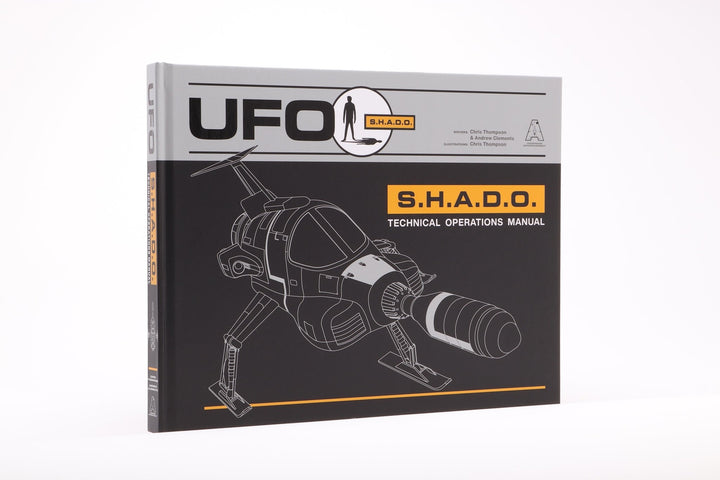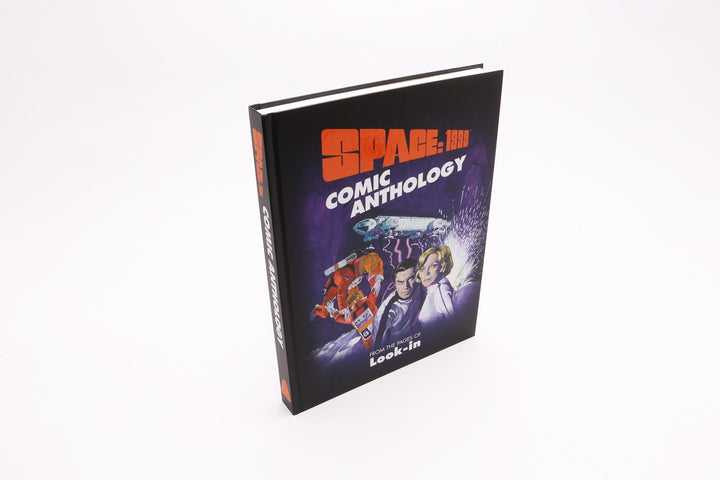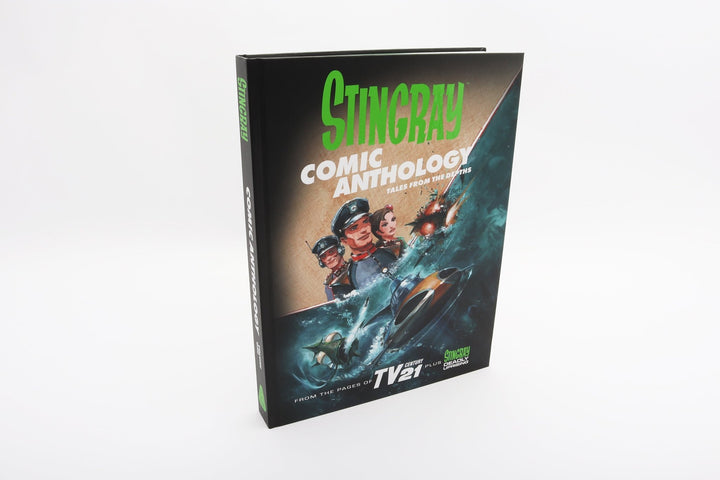Bachmann have recently re-released the Aoshima Thunderbirds model kits. Since they went on sale in our online store we've been inundated with questions asking for help and advice in building them, so we asked model builder Andi Simmons to construct a Thunderbird 2 kit and give us the lowdown on what you'll need to assemble one of your own!
Hi Anderfans, finally, the Thunderbirds are available for us all to create and have our own adventures!
Okay, first things first, make sure you have a safe, sturdy, and well-lit workspace to build your model on. If you are working from your dining table or kitchen worktop, ensure you have a cutting board to work on to protect the table or worktop surface. The basic tools you will need are a sprue nipper or sharp craft knife, a pair of tweezers, scissors and some fine glass paper or emery cloth. Remember to always use a craft knife pointing and working away from the body.

Right, enough of the boring stuff, let’s move on to the fun part. On opening your
Thunderbirds model box, you will find the printed instructions, various sprues and parts in plastic bags, the decal sheets and you will also find the unique Bachmann ‘Adventures in Plastic’ sticker.

So, before you start to build your own model you will need to study the plans to ensure you’re familiar with the sequence of how each part is put together. Construction of your model is done in stages via pictorial instructions. On these instructions you will note three sets of numbers; the number shown in a shaded box denotes the finished colour, the number shown in a circle denotes the decal and the number or letter/number combination shown (that is neither in a box nor in a circle) is the actual part that corresponds to the parts found within the sprues. If this is your first time making a plastic model kit, it may be quite daunting at first, but these
Thunderbirds kits are easy to work with and tremendous fun.
To remove a model part from the sprue, always use a sprue nipper or sharp craft knife. Don’t be tempted to twist or push the part out of the sprue as this could easily damage it. Using very fine glass paper or emery cloth (a small nail file is ideal) gently remove any rough edges found on the piece.

When gluing two model parts together always carry out a dry fit first to ensure they fit neatly together. Then, using a polystyrene based cement glue, bond the pieces together. To do this apply the glue very sparingly to one side only, it may help to apply it with a cocktail stick to minimise wastage. You can use masking tape or rubber bands to hold pieces together whilst the glue sets. Ensure plenty of time is given to allow the glue to set thoroughly. Try not get any polystyrene glue on the model itself as this could damage the plastic and spoil the final finish.
Follow each pictorial instruction, completing every part in sequence. In some diagrams there may be parts which are not meant to be glued together to allow them to move so please follow the written instructions noted on the plans and arrows with a dotted line.
Once the kit has been completed it is now time to paint your model. As with all the
Thunderbirds kits the pictorial diagram will show shaded boxes with numbers in denoting the colour of each part. Before painting your model, it should be thoroughly washed in warm soapy water to remove any oil and dust. Always ensure your model is completely dry before beginning to apply any paint.

Working in a well-ventilated area such as a garage or shed, apply a white acrylic primer to all areas of the model ensuring adequate time is left between coats to allow it to dry thoroughly. Now, you can either use acrylic aerosols for the final colours or you can hand paint the model yourself with acrylic paint and a soft paintbrush. You will note that some of the finer finishes like stripes or lines are created using the decal set so do not panic over trying to paint a long thin line!!
One thing worth remembering, the original
Thunderbirds television series was produced in a time before CGI and computers (unbelievable, isn’t it?!). Skilled model makers (like myself) and technicians created several models in varying scales depending on the shot required in the storyline. This, coupled with camera lighting from different angles, meant the various craft appeared to be different colours in certain scenes. The paint codes provided are a basic guide and I would suggest watching the episodes and referring to the photo on the box for further detailed information.
Once your paintwork has fully dried it is time to apply the decals, this is a fun part as your model will quickly start to come to life. You will notice on the pictorial instructions that the decals are also numbered, and each number is within a circle. It is easier, and recommended, to carry out this process one decal at a time.
To apply the decals, start by putting some warm water into a saucer or shallow bowl, then using a sharp knife or scissors cut out each decal from the sheet and submerge in the warm water. After 10 - 20 seconds remove the decal from the water using tweezers and gently slide the decal off the backing paper and put it into position on the model, using a soft cloth remove any excess water but don't press too hard as this will force the decal away from its desired location.
So, by now you should have your very own completed Thunderbird. We hope you have enjoyed building your model, stay tuned and have a FAB time.

 Right, enough of the boring stuff, let’s move on to the fun part. On opening your Thunderbirds model box, you will find the printed instructions, various sprues and parts in plastic bags, the decal sheets and you will also find the unique Bachmann ‘Adventures in Plastic’ sticker.
Right, enough of the boring stuff, let’s move on to the fun part. On opening your Thunderbirds model box, you will find the printed instructions, various sprues and parts in plastic bags, the decal sheets and you will also find the unique Bachmann ‘Adventures in Plastic’ sticker.
 So, before you start to build your own model you will need to study the plans to ensure you’re familiar with the sequence of how each part is put together. Construction of your model is done in stages via pictorial instructions. On these instructions you will note three sets of numbers; the number shown in a shaded box denotes the finished colour, the number shown in a circle denotes the decal and the number or letter/number combination shown (that is neither in a box nor in a circle) is the actual part that corresponds to the parts found within the sprues. If this is your first time making a plastic model kit, it may be quite daunting at first, but these Thunderbirds kits are easy to work with and tremendous fun.
To remove a model part from the sprue, always use a sprue nipper or sharp craft knife. Don’t be tempted to twist or push the part out of the sprue as this could easily damage it. Using very fine glass paper or emery cloth (a small nail file is ideal) gently remove any rough edges found on the piece.
So, before you start to build your own model you will need to study the plans to ensure you’re familiar with the sequence of how each part is put together. Construction of your model is done in stages via pictorial instructions. On these instructions you will note three sets of numbers; the number shown in a shaded box denotes the finished colour, the number shown in a circle denotes the decal and the number or letter/number combination shown (that is neither in a box nor in a circle) is the actual part that corresponds to the parts found within the sprues. If this is your first time making a plastic model kit, it may be quite daunting at first, but these Thunderbirds kits are easy to work with and tremendous fun.
To remove a model part from the sprue, always use a sprue nipper or sharp craft knife. Don’t be tempted to twist or push the part out of the sprue as this could easily damage it. Using very fine glass paper or emery cloth (a small nail file is ideal) gently remove any rough edges found on the piece.
 When gluing two model parts together always carry out a dry fit first to ensure they fit neatly together. Then, using a polystyrene based cement glue, bond the pieces together. To do this apply the glue very sparingly to one side only, it may help to apply it with a cocktail stick to minimise wastage. You can use masking tape or rubber bands to hold pieces together whilst the glue sets. Ensure plenty of time is given to allow the glue to set thoroughly. Try not get any polystyrene glue on the model itself as this could damage the plastic and spoil the final finish.
Follow each pictorial instruction, completing every part in sequence. In some diagrams there may be parts which are not meant to be glued together to allow them to move so please follow the written instructions noted on the plans and arrows with a dotted line.
Once the kit has been completed it is now time to paint your model. As with all the Thunderbirds kits the pictorial diagram will show shaded boxes with numbers in denoting the colour of each part. Before painting your model, it should be thoroughly washed in warm soapy water to remove any oil and dust. Always ensure your model is completely dry before beginning to apply any paint.
When gluing two model parts together always carry out a dry fit first to ensure they fit neatly together. Then, using a polystyrene based cement glue, bond the pieces together. To do this apply the glue very sparingly to one side only, it may help to apply it with a cocktail stick to minimise wastage. You can use masking tape or rubber bands to hold pieces together whilst the glue sets. Ensure plenty of time is given to allow the glue to set thoroughly. Try not get any polystyrene glue on the model itself as this could damage the plastic and spoil the final finish.
Follow each pictorial instruction, completing every part in sequence. In some diagrams there may be parts which are not meant to be glued together to allow them to move so please follow the written instructions noted on the plans and arrows with a dotted line.
Once the kit has been completed it is now time to paint your model. As with all the Thunderbirds kits the pictorial diagram will show shaded boxes with numbers in denoting the colour of each part. Before painting your model, it should be thoroughly washed in warm soapy water to remove any oil and dust. Always ensure your model is completely dry before beginning to apply any paint.
 Working in a well-ventilated area such as a garage or shed, apply a white acrylic primer to all areas of the model ensuring adequate time is left between coats to allow it to dry thoroughly. Now, you can either use acrylic aerosols for the final colours or you can hand paint the model yourself with acrylic paint and a soft paintbrush. You will note that some of the finer finishes like stripes or lines are created using the decal set so do not panic over trying to paint a long thin line!!
One thing worth remembering, the original Thunderbirds television series was produced in a time before CGI and computers (unbelievable, isn’t it?!). Skilled model makers (like myself) and technicians created several models in varying scales depending on the shot required in the storyline. This, coupled with camera lighting from different angles, meant the various craft appeared to be different colours in certain scenes. The paint codes provided are a basic guide and I would suggest watching the episodes and referring to the photo on the box for further detailed information.
Once your paintwork has fully dried it is time to apply the decals, this is a fun part as your model will quickly start to come to life. You will notice on the pictorial instructions that the decals are also numbered, and each number is within a circle. It is easier, and recommended, to carry out this process one decal at a time.
To apply the decals, start by putting some warm water into a saucer or shallow bowl, then using a sharp knife or scissors cut out each decal from the sheet and submerge in the warm water. After 10 - 20 seconds remove the decal from the water using tweezers and gently slide the decal off the backing paper and put it into position on the model, using a soft cloth remove any excess water but don't press too hard as this will force the decal away from its desired location.
So, by now you should have your very own completed Thunderbird. We hope you have enjoyed building your model, stay tuned and have a FAB time.
Working in a well-ventilated area such as a garage or shed, apply a white acrylic primer to all areas of the model ensuring adequate time is left between coats to allow it to dry thoroughly. Now, you can either use acrylic aerosols for the final colours or you can hand paint the model yourself with acrylic paint and a soft paintbrush. You will note that some of the finer finishes like stripes or lines are created using the decal set so do not panic over trying to paint a long thin line!!
One thing worth remembering, the original Thunderbirds television series was produced in a time before CGI and computers (unbelievable, isn’t it?!). Skilled model makers (like myself) and technicians created several models in varying scales depending on the shot required in the storyline. This, coupled with camera lighting from different angles, meant the various craft appeared to be different colours in certain scenes. The paint codes provided are a basic guide and I would suggest watching the episodes and referring to the photo on the box for further detailed information.
Once your paintwork has fully dried it is time to apply the decals, this is a fun part as your model will quickly start to come to life. You will notice on the pictorial instructions that the decals are also numbered, and each number is within a circle. It is easier, and recommended, to carry out this process one decal at a time.
To apply the decals, start by putting some warm water into a saucer or shallow bowl, then using a sharp knife or scissors cut out each decal from the sheet and submerge in the warm water. After 10 - 20 seconds remove the decal from the water using tweezers and gently slide the decal off the backing paper and put it into position on the model, using a soft cloth remove any excess water but don't press too hard as this will force the decal away from its desired location.
So, by now you should have your very own completed Thunderbird. We hope you have enjoyed building your model, stay tuned and have a FAB time.




![Fireball XL5 World Space Patrol Technical Operations Manual [HARDCOVER BOOK] - The Gerry Anderson Store](http://gerryanderson.com/cdn/shop/files/fireball-xl5-world-space-patrol-technical-operations-manual-hardcover-book-290050.jpg?v=1711729272&width=720)



![Stingray Comic Anthology Volume Two – Battle Lines [HARDCOVER] - The Gerry Anderson Store](http://gerryanderson.com/cdn/shop/files/stingray-comic-anthology-volume-two-battle-lines-hardcover-107681.jpg?v=1738856151&width=720)
![Space: 1999 and UFO Book Bundle - Signed Limited Editions [HARDCOVER NOVELS] - The Gerry Anderson Store](http://gerryanderson.com/cdn/shop/files/space-1999-and-ufo-book-bundle-signed-limited-editions-hardcover-novels-589446.jpg?v=1718836845&width=720)
![Stingray WASP Technical Operations Manual Special Limited Edition [HARDCOVER BOOK] - The Gerry Anderson Store](http://gerryanderson.com/cdn/shop/files/stingray-wasp-technical-operations-manual-special-limited-edition-hardcover-book-991914.jpg?v=1732922875&width=720)
![Stingray: The Titanican Stratagem – Signed Limited Edition [HARDCOVER NOVEL] - The Gerry Anderson Store](http://gerryanderson.com/cdn/shop/files/stingray-the-titanican-stratagem-signed-limited-edition-hardcover-novel-129251.jpg?v=1740558711&width=720)






